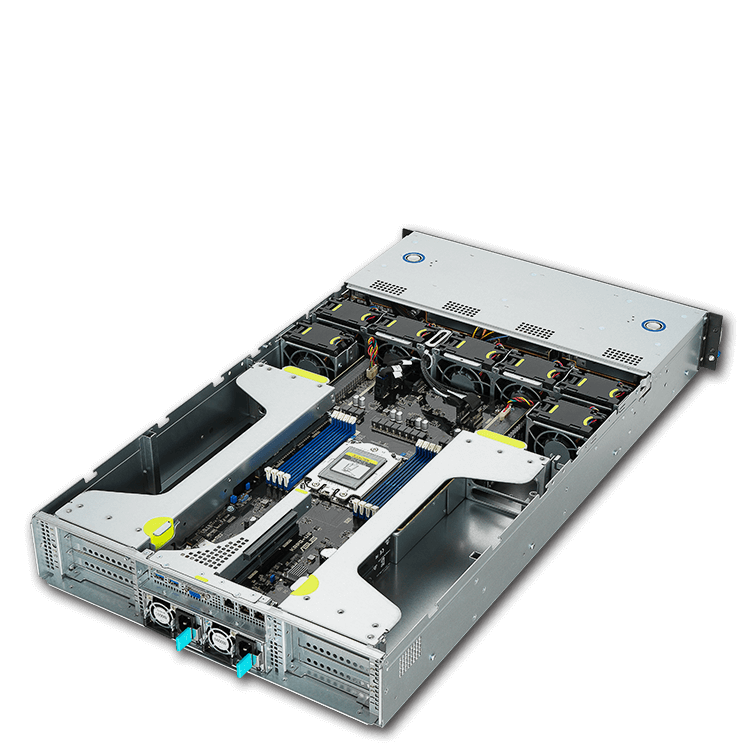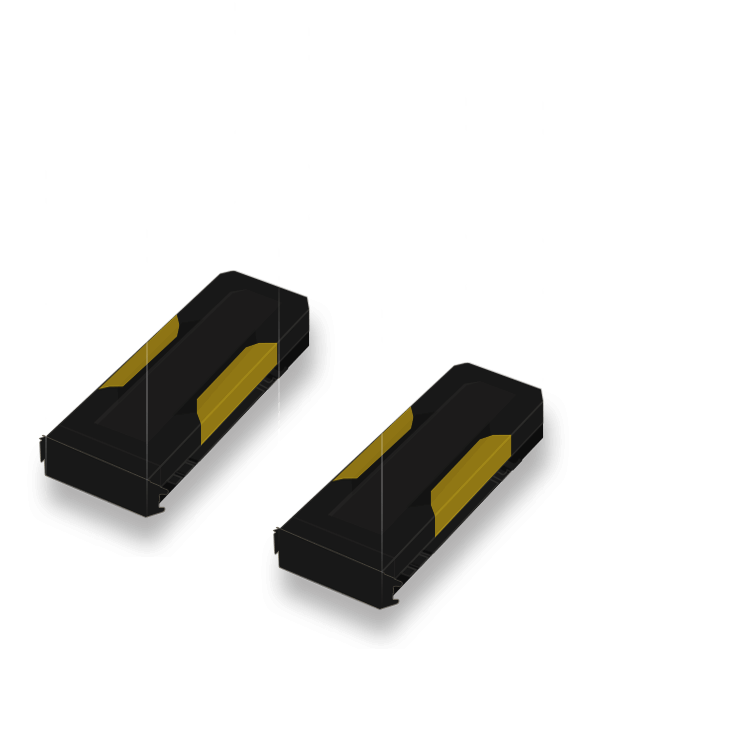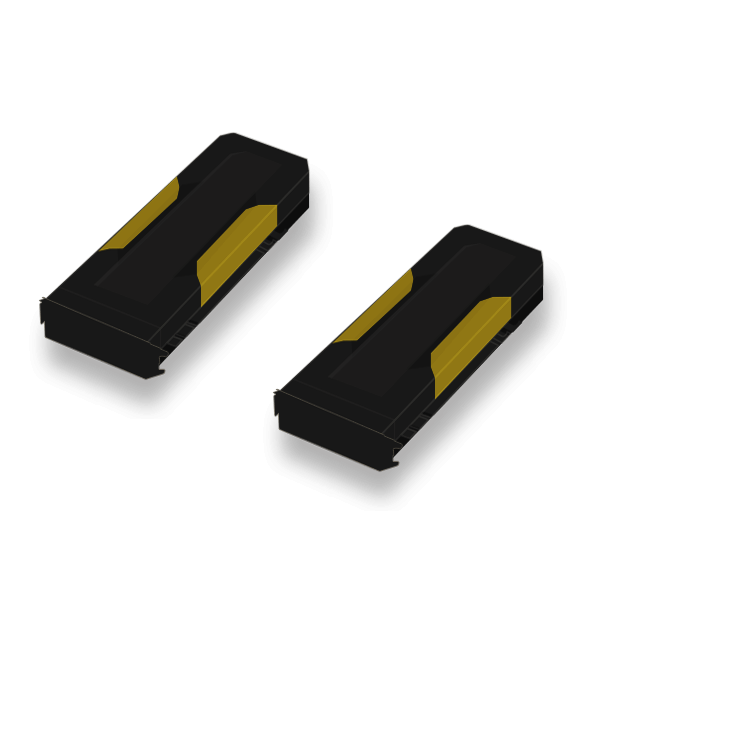Multiple GPUs
4 x PCIe Gen 4.0 x16 slots (x16 link), double-slot GPUs, or
8 x PCIe Gen 4.0 x16 slots (x16 link) with PLX SKU board for single-slot GPUs.
The AMD EPYC™ 7003 & 7002 processor features the world's first 7nm datacenter-design and a PCI Express® 4.0-capable x86 server processor with up to 2X the performance and 4X the floating-point capability. With support for up to 64 cores, 128 threads, 8-channel DDR4 3200, 128 PCIe 4.0 lanes and up to 280 watts of max. thermal design power (TDP), this processor also includes memory and virtualization encryption features to ensure exceptional security.
PCIe® 4.0 delivers 16 GT/s bandwidth — double the speed of PCIe 3.0 — while offering lower power consumption, better lane scalability and backwards compatibility. ASUS ESC4000A-E11 features up to eleven PCIe 4.0 slots to support a diverse array of graphics, storage and networking applications, such as HBA/RAID, NIC and InfiniBand (IB) cards.




Butterfly Riser Cards
2 x PCIe Gen 4.0 x16 slots (x32 link)
Multiple GPUs
4 x PCIe Gen 4.0 x16 slots (x16 link), double-slot GPUs, or
8 x PCIe Gen 4.0 x16 slots (x16 link) with PLX SKU board for single-slot GPUs.
Front Riser Card
1 x PCIe Gen 4.0 x8 slot (x8 link)
Butterfly Riser Cards
2 x PCIe Gen 4.0 x16 slots (x32 link)
Multiple GPUs
4 x PCIe Gen 4.0 x16 slots (x16 link), double-slot GPUs, or
8 x PCIe Gen 4.0 x16 slots (x16 link) with PLX SKU board for single-slot GPUs.
Front Riser Card
1 x PCIe Gen 4.0 x8 slot (x8 link)
ESC4000A-E11 features a powerful GPU architecture that supports up to four double- slot or eight single-slot GPUs in a 2U chassis, including NVIDIA® A100 and AMD Instinct™ MI100 accelerator to meet the demands of AI and HPC, and to securely run workloads in virtualization environment. It is also a Xilinx Alveo-qualified server to provide optimized acceleration for hybrid cloud environments in financial computing, machine learning, computational storage, and data search and analytics.
* Verification is available on request.



ESC4000A-E11 features a flexible front panel design that allows for easy storage and network expansions and upgrades. The design offers easier accessibility of up to four NVMe SSD drives and an optional choice of OCP 3.0, a hyper M.2 adapter or HBA/RAID card via PCIe 4.0 slot for better performance and lower latency.


ESC4000A-E11 is a NVIDIA RTX server validate system that deliver unprecedented performance at a fraction of the cost, space, and power requirements of traditional CPU-based solutions, from production rendering to scalable visualization systems or HPC, AI, ML, big data analytics, and at the edge deployment options.
ESC4000A-E11 features a OCP 3.0 NIC card to deliver speeds of up to 200 Gbps for HPC applications that require high-bandwidth, low-latency network support for connecting multiple nodes and clusters.
To effectively manage the storage demands of growing amounts of data, ESC4000A-E11 has a dense chassis design that accommodates up to eight 3.5-inch or 2.5- inch drives, including up to four NVMe SSDs support. One onboard 22110-length M.2 SSD allows faster data transfer speeds for OS installation, and a hyper M.2 card is available to provide even greater expansion capability.
ASUS ESC4000A-E11 servers integrate PFR FPGA as the platform Root-of-Trust solution for firmware resiliency to prevent from hackers from gaining access to infrastructure. ASUS security solutions are fully compliant with the 2018 National Institute of Standards and Technology (NIST) SP 800 193 specification.
In addition, all ESC4000A-E11 servers also include support Trusted Platform Module 2.0 (TPM 2.0) to secure hardware through integrated cryptographic keys and offer regular firmware update for vulnerabilities.
The TPM-M and TPM SPI difference and supported product list
* Platform Firmware Resilience (PFR) module must be specified at time of purchase and is factory-fitted. It is not for sale separately.

ASUS ASMB10-iKVM is the latest server-management solution from ASUS, built upon the ASPEED 2600 chipset running on the latest AMI MegaRAC SP-X. The module provides various interfaces to enable out-of-band server management through WebGUI, Intelligent Platform Management Interface (IPMI) and Redfish® API.

ASUS Control Center (ACC) is a centralized and integrated IT-management platform for monitoring and controlling ASUS servers, workstations and mini PCs. ACC enables remote BIOS updates, monitoring of multiple systems via mobile devices, and one-click software updates and dispatching, allowing easier server management for any IT infrastructure.

ASUS servers feature exclusive Performance Boost technology to achieve the best server performance and agility by tuning servers to match the requirements of workloads, letting you gain greater control of your server environment. This technology improves workload throughput by maximizing processor frequency and boost power, ideal for time-sensitive applications such as financial services or data center operations. In the BIOS you can choose from pre-configured server profiles optimized for specific workloads, maximizing overall performance and reducing server-configuration time.


Engine Boost Increase Performance

Maximizes the processor frequency in multi-core operations, avoiding frequency shifting for reduced latency.

Automatic power acceleration with an innovative voltage design to increase server overall performance.

Preconfigured BIOS server profiles based on workloads and benchmarks for improved performance and efficiency.
* Benchmark: MP Linpack
* Configuration: ESC4000A-E11 | OS: SLES 15|DIMM: DDR4 2933 2Rx4 32GB x 12pcs | BIOS Setting: BIOS 5102 with HT disabled
ASUS features server thermal-control technologies to provide real-time server temperature monitoring, intelligent fan-curve adjustments, and continue delivering the value of optimized power-efficiency.
ASUS Thermal Radar 2.0 takes advantage of placing up to 56 ambient sensors on the front panel of a server as well as in components for temperature monitoring. It can perform intelligent fan-curve adjustments to fit the real-time server usage patterns, lowering fan power-consumption by up to 36% and reducing total cost of ownership — ideal for data centers with extreme workloads.

Sensors are embedded on front panel, CPU, NVMe SSD, OCP card, PSU and memory. Up to 56 ambient sensors on selected models.

Fans are grouped for dynamic fan curve adjustment in different fan zones to achieve more precise thermal monitoring.

More precise thermal information can reduce power consumption and lower down TCO.
ASUS Power Balancer is an exclusive technology that enables ASUS servers to adjust overall loading automatically based on real-time monitoring in order to decrease overall power consumption for improved efficiency and cost/performance optimization.

Monitor and feedback CPU loading to have more accurate management on the system.

Dynamically and automatically adjust CPU frequency based on current utilization to reduce power consumption.

Optimize performance per watt for a better power efficiency system.